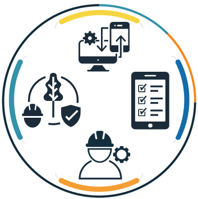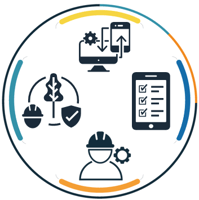5 min read
New OSHA Ruling Expands EHS Data Reporting Requirements
By: Ideagen DevonWay on November 30, 2023

A new OSHA ruling will take effect Jan. 1, 2024, that expands submission requirements for injury and illness data for more employers in high-hazard industries. The Improve Tracking of Workplace Injuries and Illnesses Electronic Submission ruling now requires certain employers to electronically submit injury and illness information to OSHA. While employers are already required to keep this information, the ruling requires them to submit it digitally, along with other additional information.
This data will be published on the OSHA website, making it easier for employers, employees, customers, stakeholders and the general public to access information about a company’s workplace safety and health records.
Find out what the Improve Tracking of Workplace Injuries and Illnesses Electronic Submission ruling means for employers – and what you can do to prepare.
What is the new OSHA ruling?
Starting in 2024, certain employers will be required to electronically submit their Form 300 and Form 301 data to the U.S. Department of Labor’s Occupational Safety and Health Administration (OSHA). While some large employers are already required to do so, this ruling requires more establishments to follow suit and electronically share information about injuries and illnesses that occur in their workspaces.
These employers must electronically submit detailed information once a year about each recordable injury and illness. This information includes:
- The date of the illness or injury
- Physical location
- Severity of the injury or illness
- Details about the worker who was injured
- Details about how the incident occurred
To protect the privacy of individuals, OSHA will not collect certain information such as the injured or ill employee’s name, and will omit other key identifiers such as address, telephone number, birthday, etc.
Employers must also include the legal name of their company when submitting the data to make it easier for stakeholders accessing the information to identify the establishment.
Which establishments have to submit?
Employers with 100 or more employees in certain high-hazard industries must now electronically submit information from their Form 300 (Log of Work-Related Injuries and Illnesses) and Form 301 (Injury and Illness Incident Report) to OSHA once a year.
The ruling also upheld the current requirements for electronic submission of Form 300A from establishments with 20-249 employees in certain high-hazard industries, as well as from employers with 250 or more employees in industries that must routinely keep OSHA injury and illness records.
Some of the high-risk industries identified to comply include:
- Agriculture, forestry, fishing and hunting
- Construction
- Manufacturing
- Utilities
- Water, sewage and other systems
- Warehousing and storage
OSHA estimates about 50,000 employers will be required to submit this data, and it’s predicted some 750,000 injury and illness cases will be reported annually.
According to OSHA, focusing the requirements on high-hazard establishments with 100 or more employees equates to fewer than 1% of establishments in the United States having to submit additional data; however, the injury and illness data submitted by those employers are estimated to comprise about 30% of all reportable occupational injuries and illnesses.
Why the change?
There are two primary factors driving the updates to this requirement. To start, it’s hoped the new ruling will benefit OSHA’s effectiveness, as case-specific injury and illness data will help OSHA better identify specific hazards, to then avoid them in the future. The added data will provide the opportunity for further analysis, creating more accurate statistics when it comes to work-related injuries and illnesses that can be used to drive change.
Secondly, creating public access to injury and illness data offers stakeholders – from employees to employers to potential customers – the opportunity to make more informed decisions about workplace safety and health for specific establishments.
Overall, those at OSHA believe that providing public access to the data will ultimately reduce occupational injuries and illnesses.
"Congress intended for the Occupational Safety and Health Act to include reporting procedures that would provide the agency and the public with an understanding of the safety and health problems workers face, and this rule is a big step in finally realizing that objective," explained Assistant Secretary for Occupational Safety and Health Doug Parker in a press release.
"OSHA will use these data to intervene through strategic outreach and enforcement to reduce worker injuries and illnesses in high-hazard industries. The safety and health community will benefit from the insights this information will provide at the industry level, while workers and employers will be able to make more informed decisions about their workplace's safety and health."
Learn more about the new OSHA ruling by visiting OSHA’s Injury Tracking Application page.
How should companies prepare?
The new OSHA ruling is just one of many new EHS requirements rolling out as the United States and the world moves toward more accountable practices. There are a few steps companies can take to ensure they’re ready for additional reporting requirements.
It’s critical to have a strong, reliable software system to capture EHS data from the start. Make sure it’s easy for workers to create incident reports in the moment, including all of the fields that will be required down the line, from parties involved to the extent of injuries and more.
It’s never been more important to improve an organization’s health and safety, not only to protect its workforce, but – as data is more widely shared – to protect its reputation too. Be sure your organization is analyzing injuries and illnesses that occur, to spot trends and make changes to minimize risks into the future.
How Ideagen DevonWay can help
Ideagen DevonWay offers a single, secure system to capture, analyze, audit and report data from across an organization. Among the many solutions, our Incident Management empowers everyone from the field to the office to participate in incident management with an intuitive mobile app for capturing incidents on the spot and a desktop application for tracking and analyzing issues. While every company manages incidents differently, our system is highly configurable, without code, to meet your exact business rules, regulations, and workflows now and when they evolve. It connects seamlessly with other DevonWay applications and to your existing systems.
Real-time visibility provides information for increased safety and risk assessment information, providing the opportunity to reduce risks of injury, illness and financial liability.
Ready to learn more? Request a free demo today to see how Ideagen DevonWay can help your organization meet compliance and take steps toward providing a safer and healthier work environment.
Related Posts
DevonWay & Rombit: A Powerful Partnership For More EHS Data
Every organization strives for environmental, health and safety (EHS) excellence – and achieving...
DevonWay for GRC: One platform, full GRC coverage
DevonWay is often asked if we offer software for Governance, Risk, and Compliance (GRC). The answer...
Top 5 Reasons to Improve Your ESG Reporting Now
If your organization hasn’t started thinking about how to improve ESG reporting, it’s time to make...





